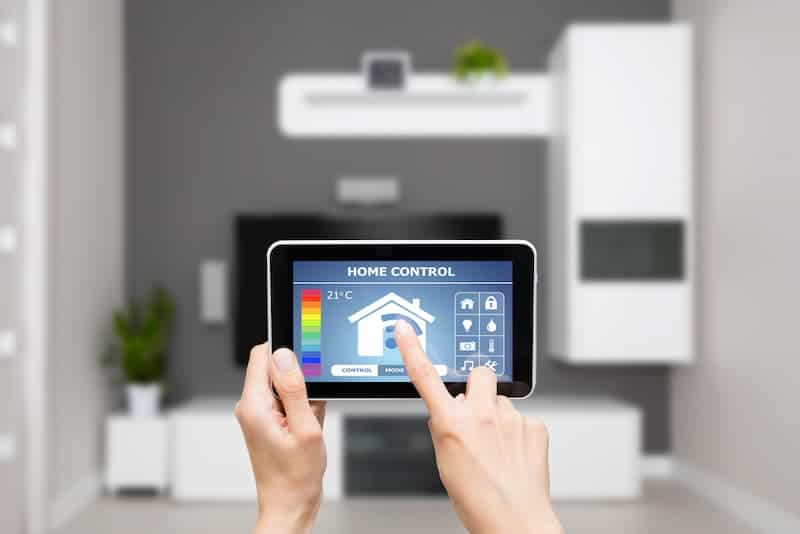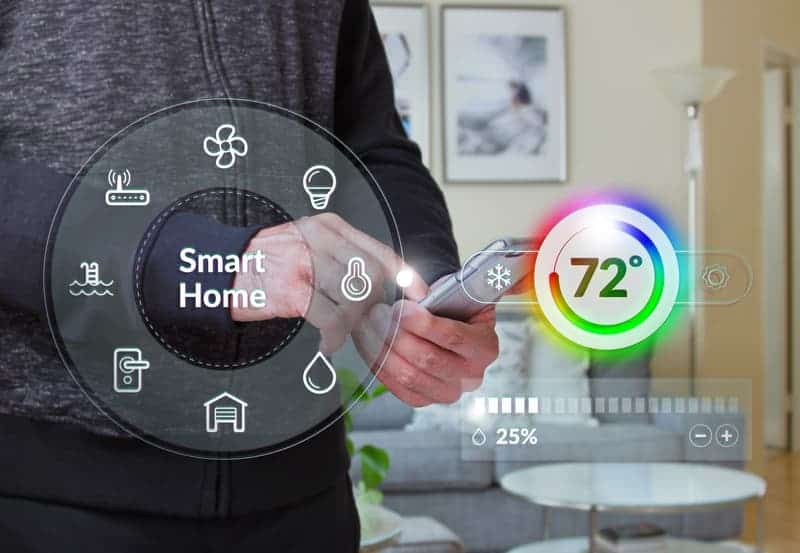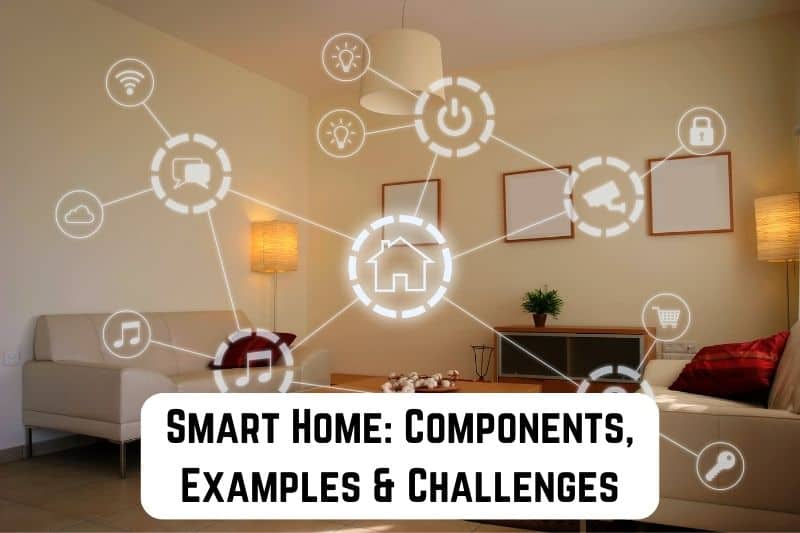One of the hottest terms in 2024 is “smart home,” but what does that mean? In a word, an Internet of Things (IoT)-enabled house is one in which specific objects are linked to the internet. This may include everything from voice-activated light bulbs to smart security cameras that allow you to watch live video from a mobile app.
Voice assistants like Alexa or smartphone apps can operate WiFi-connected appliances in smart homes. Typical examples of smart home appliances are locks, thermostats, lighting, and more. Thanks to its cost-saving features and convenience, smart homes are growing in popularity.
Read: Pros and Cons of Tiny House Living
What is a Smart Home?
A “smart home” is a convenient configuration of appliances and other gadgets that can be automatically managed remotely using a mobile device or other networked device from any location with an internet connection.
The internet connects all the devices in a smart home, giving the user remote control over lighting, temperature, security access, and home entertainment systems.
Smart home systems and gadgets, a component of the Internet of Things, frequently work in tandem, exchanging usage data with one another and automating tasks according to the homeowners’ preferences. Every piece of equipment in a smart home is networked and controlled from a single hub, such as a laptop, gaming console, tablet, or smartphone.
One home automation system may operate door locks, TVs, thermostats, cameras, house monitors, lighting, and even appliances like the refrigerator. The user can set up time schedules for the system to take effect on a mobile or networked device.
Components of a Smart Home
A smart home is more than just a few smart appliances that you can use to automate one or two tasks. It’s about building a connected, effective system that makes daily life easier. Here are the five key elements that are the framework for every well-thought-out smart home to do this.
Smart Home Hubs
The hub, which links and controls all your intelligent components, is essential to the smart home control system. Like the brain, it ensures all parts communicate and function as a unit. Consider it the centerpiece of your smart home system. The Samsung SmartThings Hub, Google Home, and Amazon Echo Plus are a few examples.
Connectivity and Networking
Any smart home’s network is its foundation. High-quality mesh networks and routers, such as those from Netgear or Google Nest Wifi, offer dependable and long-range connections. This is essential for the smooth operation of all smart devices.
Smart Lighting
Upgrade your home’s lighting with smart switches and bulbs with scheduling, color changing, dimming, and remote control capabilities. Popular options like Philips Hue and LIFX can adjust to your feelings and even sync with movies or music.
Smart Thermostats
Devices like the Ecobee and Nest Thermostats modify the heating and cooling according to your routines to keep you comfortable and conserve energy. They adapt to maintain efficiency whether or not they detect your presence.
Intelligent Sensors
These ingenious gadgets detect changes in your home. They can check for light, measure heat, see movement, and even locate leaks in water. Brands like Fibaro and Aeotec offer sensors that may transmit notifications or cause other devices to react to a change.

Examples of Smart Home Systems
IoT-powered hardware must be connected to an ecosystem via an Internet connection for a home to become intelligent and self-driving. You may find smart home technology in a modern connected home for almost every chore, from brewing coffee to watching over your pet while you’re gone. These are a few examples of the technology you can provide to your client’s smart home ecosystem.
Access & Security Controls
Since they effectively maintain a home’s security, home security systems are frequently ranked among the best smart home solutions. When someone approaches their home, smart video doorbells, motion detectors, and cameras alert users from a distance.
They can access the doors using smart locks even when not there, allowing them to lock or unlock the door upon request automatically or if it was inadvertently left unlocked.
Energy Management Systems
The greatest smart home systems incorporate ways to save resources like water and electricity, even though most connected home appliances are designed to make life easier and more comfortable. By ensuring that there are no leaks or excessive energy use in the house, these systems allow consumers to live more sustainably and pay less for their bills.
Lighting Controls
These days, intelligent lights are most likely the fundamental elements of contemporary smart home systems. In addition to setting auto turn on and off and synchronizing with the time of day, they enable remote control of the light’s color and brightness. Smart light bulbs and switches not only let users create the ideal environment but also let them save money on energy costs.
Climate Controls
People increasingly use innovative technology to create and manage the ideal atmosphere in their homes, all at the touch of a button. Homeowners can also monitor the air quality on their smartphones by using climate control products like humidifiers, air purifiers, and thermostats, which transfer information about temperature, humidity, and pollution levels to a specific app.
Are Smart Homes Sustainable?
Sustainable living is possible with smart houses because they are outfitted with state-of-the-art technology that maximizes energy efficiency and improves convenience. By monitoring and managing energy consumption, homes can lessen their influence on the environment thanks to integrating smart gadgets.
Intelligent lighting, smart appliances, and automated climate control systems maximize energy efficiency and reduce total resource use. Smart houses have several benefits related to sustainability, one of which is their capacity to adjust to the actions of their residents.
By analyzing behavior patterns, machine learning algorithms enable the system to anticipate needs and make necessary adjustments. This flexibility reduces wasteful energy use while also improving user comfort.
Smart houses frequently include renewable energy sources like solar panels and energy storage devices to further lessen dependence on traditional power networks. However, there are worries about how producing and discarding smart devices affects the environment.
Technology is advancing so quickly that some devices may become obsolete too soon, adding to the amount of electronic trash produced. Maintaining the long-term viability of smart homes requires finding a balance between ecological responsibility and innovation.
Smart homes can persist in their evolution as a driving force for sustainable living in the contemporary day through responsible utilization of developing technology and addressing these obstacles.

Challenges and Considerations
Smart home technology can provide a seamless and practical living environment when integrated with futuristic interior design. However, when integrating smart home technology into futuristic interior design, there are challenges and considerations.
Cost
Many smart home appliances remain pricey, even with price reductions, and a whole home renovation may run into the thousands of dollars. Integrating smart home technologies into a futuristic interior design may necessitate a substantial financial outlay. Furthermore, the cost of some smart home appliances may increase if they need regular upkeep and updates.
Privacy and Security
Cybersecurity and privacy breaches are a constant danger associated with smart home technologies. Ensuring the security of technology and protecting personal data is crucial.
Because most IoT devices don’t have encryption built in, there are security risks associated with them. Furthermore, they can act as entry points for sensitive data on the more extensive network, expanding the attack surface.
Technical Support
Due to the complexity of smart home technology, homeowners may need technical help to install and maintain the equipment. This can be not easy, particularly for people who are not tech-savvy, and it might cost more for expert installation and upkeep.
The Future of Smart Homes
Modern technology has revolutionized Smart Home Systems (SHS), making them indispensable in daily living. These systems combine cutting-edge technology with energy-efficient design to create intelligent, secure, and convenient homes. There are even more opportunities in store for SHS in the future, including automation powered by AI and renewable energy sources.
Emerging Trends
Innovative trends and technology that improve convenience and automation are driving the fast evolution of the smart home market. The most popular smart home trends are outlined here, along with a few bright new companies influencing them.
Smart Home Connectivity
Wireless connection technologies enable flawless device operation and are essential for intelligent home control. High-bandwidth wireless protocols are provided by startups such as SPARK to facilitate effective device connection.
Smart Home Security
By employing sensors and surveillance to prevent break-ins, smart security solutions boost automation. Smart door locks that could be controlled remotely are offered by startups like DEN, improving security.
Customized Health Care
State-of-the-art technologies, such as health tracking, sleep aids, and touchless solutions, specifically concentrate on managing each person’s health. Gense offers health monitoring gadgets that can be used at home to identify diseases early.
Home robotics
From cleaning to helping homeowners, robots automate household chores. Coral Robots creates robotic vacuum cleaners, and Sunny’s robot assistant has AI-powered features.
Potential Development
Exciting improvements in smart home technology and a greater emphasis on convenience and sustainability are expected. Important areas for future growth include.
Integration of AI and Machine Learning
As AI and Machine Learning algorithms learn from and adjust to occupants’ habits, tastes, and daily routines, smart homes will get even more intelligent. Automation, as a result, will become more effective and customized.
Interconnectivity and Standardization
It is anticipated that more manufacturers of smart home devices will work together to enhance interoperability and standardization. This will improve how well various devices integrate into the home network.
Enhanced Security Measures
In response to new dangers, security elements in smart homes will change as they become more common. This includes enhanced cybersecurity processes, biometric authentication, and sophisticated encryption to safeguard user data and privacy.
Read: 15 Splendid Ways to Make a Minimalist Home
Integration of Health and Wellness
Devices for tracking health and wellness will be progressively included in smart homes. These technologies, ranging from integrated health monitors to smart mattresses that monitor sleep patterns, will help provide proactive home healthcare.
Conclusion
By utilizing technological advancements and innovation, smart homes simplify tasks. Smart homes have entirely changed how people live, use energy, and communicate with their household appliances. Examples of these innovations include scheduling tasks to complete chores at specific times or using your phone to manage applications.






